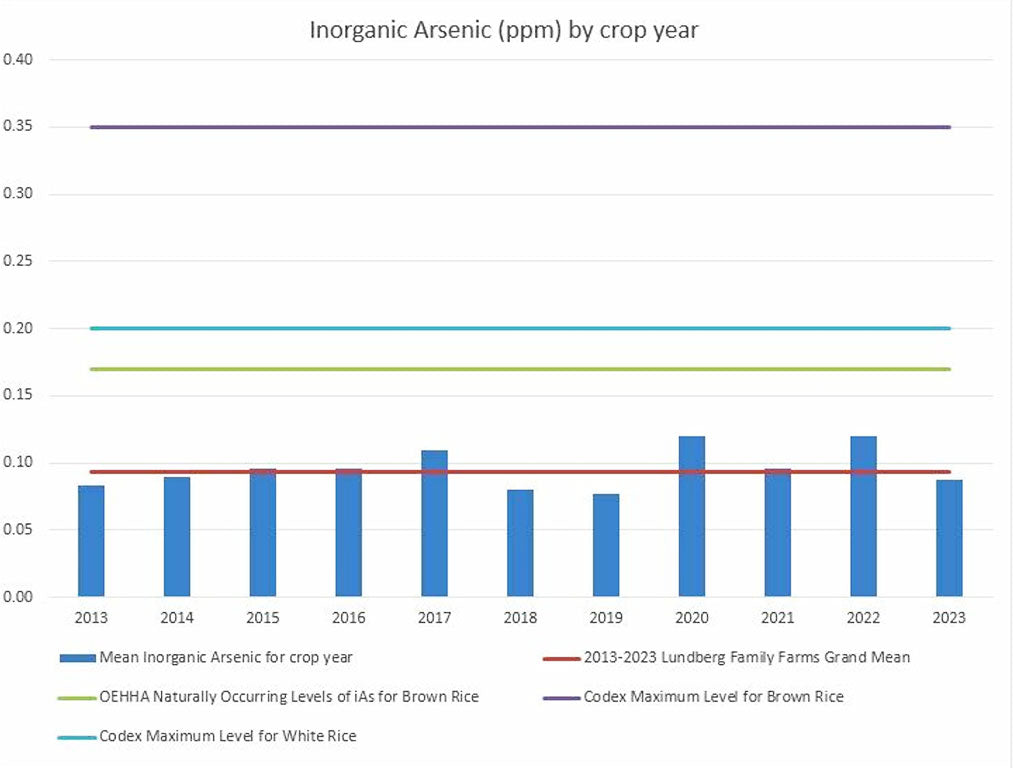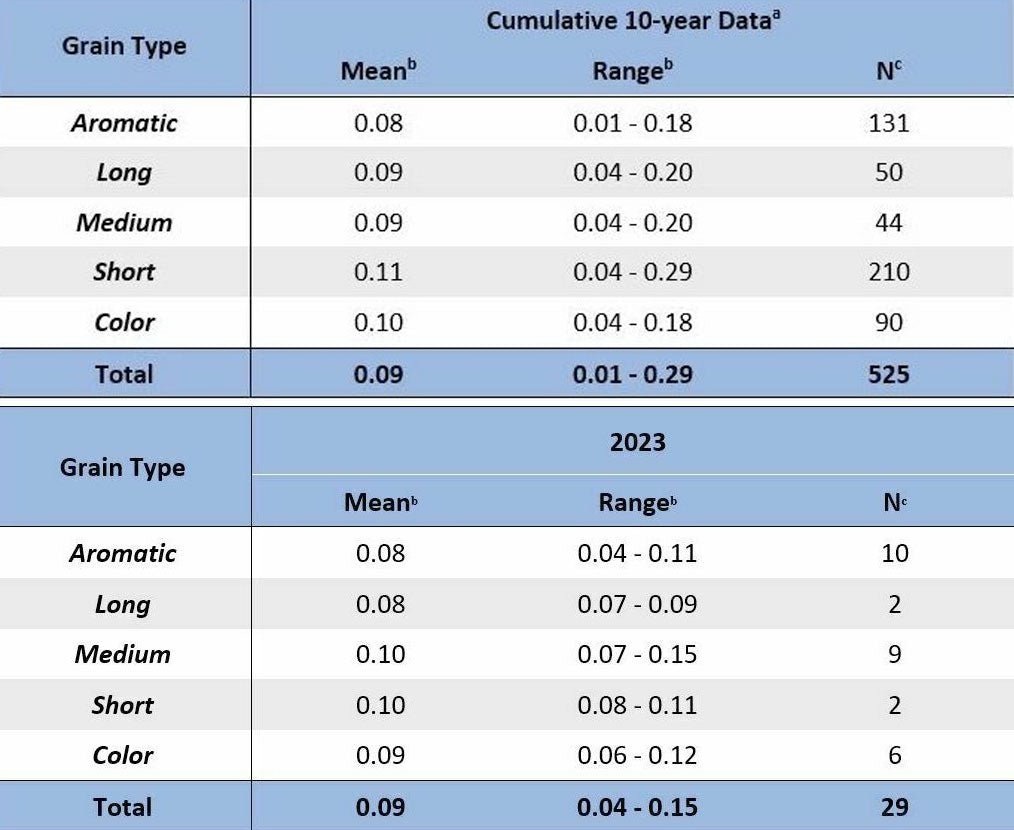Heavy Metals in Food
Arsenic is a naturally occurring element found in soil, water, plants, and animals. Because arsenic exists in soil and water, it’s inevitably found in many plants and food, including rice. Arsenic can also be found in flour, corn, wheat, fruit, poultry, vegetables, beer, and wine. Like arsenic, cadmium can be naturally occurring in the environment and therefore found in food.
Since 2013, we’ve regularly tested our rice for heavy metals, and our results consistently fall well below the limits set by regulatory agencies, including the FDA, European Food Safety Authority (EFSA), CODEX (a collection of standards, guidelines, and codes of practice adopted by the central part of the Joint FAO/WHO Food Standards Programme), and California’s Proposition 65.
Our arsenic testing at AGQ Labs—a third-party, accredited lab—found that our rice averaged 90 ppb (0.09 ppm), which is far below both FDA and EU standards:

Our 11-year average was 0.09 ppm, with a range of 0.01 – 0.29 ppm. As farming practices were similar between the crop years, variability across these years may be attributed to differences in weather patterns and the volume of different varieties grown in each year. The tables below represent inorganic arsenic (iAs) content in different types of rice for the 2012 – 2023 crop years:

We also test our rice for cadmium each year. The European Food Safety Authority regulation established 115 ppb (0.15 ppm) as the maximum level for cadmium in food and CODEX states the maximum level (ML) for cadmium in white rice as 400 ppb (0.4 ppm). The average of our testing is less than 13 ppb (0.013 ppm), well below the maximum levels set by the European Food Safety Authority and CODEX.
Have more questions? Here are some FAQs about heavy metals in food:
Arsenic is a naturally occurring element found in soil, water, plants, and animals. Because arsenic exists in soil and water, it’s inevitably found in many plants and food, including rice. Arsenic can also be found in flour, corn, wheat, fruit, poultry, vegetables, beer, and wine.
Some studies suggest that human activity can elevate arsenic levels and we support ongoing research to utilize natural systems to minimize levels of inorganic arsenic in the food supply.
Arsenic exists in two forms: organic and inorganic which, in this case, does not refer to farming practices but chemistry. Inorganic arsenic is more rapidly absorbed than organic arsenic and generally considered more toxic. For this reason, we test specifically for inorganic arsenic and our results consistently fall well below the limits set by regulatory agencies, including the FDA, European Food Safety Authority (EFSA), CODEX (a collection of standards, guidelines, and codes of practice adopted by the central part of the Joint FAO/WHO Food Standards Programme), and California’s Proposition 65.
Like arsenic, cadmium can be naturally occurring in the environment and therefore found in food.
We test our rice annually as it comes in from the fields. We create a composite sample for each of our varieties, mill it to brown rice, and then send it to AGQ Labs, an accredited, third-party lab that tests to ISO standards (global standards for trusted goods and services) for arsenic, cadmium, and lead.
1 ppm = one part per million, which is equivalent to one second in 11.5 days, one drop of ink in a 10-gallon fish tank, or 10 bricks from the entire Empire State Building.
1 ppb = one part per billion, which is equivalent to about one drop of ink in a 10,000-gallon swimming pool, the width of 1 human hair in 68 miles, or 1 second per 32 years.
Our arsenic results are less than half the daily No Significant Risk Level (NSRL) established by the California’s Proposition 65, which is one of the strictest limits set by regulatory agencies.
Our cadmium results are approximately 10 times lower than the daily Maximum Allowable Dose Level (MADL) established by California’s Proposition 65, which is one of the strictest limits set by regulatory agencies.
Because arsenic and cadmium are naturally occurring in the environment and our test results consistently fall well below the limits set by regulatory agencies, we are not actively working to strip the soil of heavy metals. That said, we continue to use regenerative organic farming practices to build and maintain healthy soil.
Organic, Regenerative Organic Certified®, and conventional rice all contain arsenic, which is a naturally occurring element found in soil, water, plants, and animals. Arsenic can also be released into the environment through arsenic-based pesticides, which were used in cotton growing regions to control boll weevils. Because of this, concentrations can vary depending on the region where rice is grown. Concentrations can also vary by rice variety.
Yes, and here’s why: Rice starts life as whole grain that includes three parts: the bran, the germ and the endosperm. This is essentially brown rice. White rice is a refined grain, which consists of just the endosperm. The bran and germ, which contain many nutrients in rice, are removed in the milling process to create white rice.
As reported by the FDA’s 2016 study of rice products, brown rice had approximately twice the concentration of inorganic arsenic compared with white rice (Arsenic in Rice and Rice Products Risk Assessment Report, March 2016). Additionally, brown rice has significantly higher levels of vitamin B, manganese, phosphorus, iron and fiber than white rice.
Our testing of inorganic arsenic in rice is focused on our brown rice. Our results consistently fall well below the limits set by regulatory agencies, including the FDA, European Food Safety Authority (EFSA), CODEX (a collection of standards, guidelines, and codes of practice adopted by the central part of the Joint FAO/WHO Food Standards Programme), and California’s Proposition 65.
Chronic exposure to inorganic arsenic can elevate the risk of cancer. The levels of exposure in which this correlation has been documented has been at levels substantially greater than the levels found in rice. In some studies that observed the effects of poor water quality, scientists have found that high oral exposure to arsenic over time caused acute and long-term adverse health effects 1.
We support the FDA’s recommendation for the general public to eat a balanced and diversified diet that includes a variety of grains in order to ensure good nutrition. In addition, we support the FDA initiative, Closer to Zero, to reduce heavy metal risks, including arsenic, for infants and young children in their food 2.
1 https://www.who.int/news-room/fact-sheets/detail/arsenic
2 https://www.fda.gov/food/environmental-contaminants-food/closer-zero-action-plan-baby-foods
If a consumer wants to further reduce arsenic exposure, we recommend rinsing rice prior to cooking it, which can help remove excess starch and some amount of arsenic.
Last Updated: 5/1/2025
